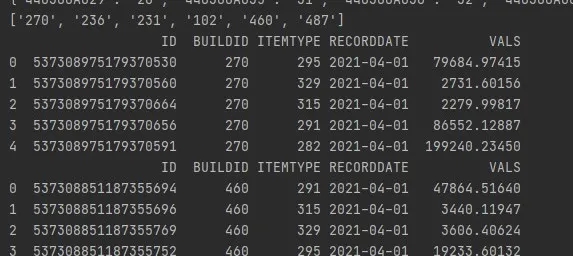基于底层数据来开发不难,无非是将用户输入变量作为筛选条件,将参数映射到 sql 语句,并生成一个 sql 语句然后再去数据库执行
最后再利用 qt 开发一个 gui 界面,用户界面的点击和筛选条件,信号触发对应按钮与绑定的传参槽函数执行
具体思路:
一、数据库连接类
此处利用 pandas 读写操作 oracle 数据库
二、主函数模块
1)输入参数模块,外部输入条件参数,建立数据库关键字段映射
--注:读取外部 txt 文件,将筛选字段可能需要进行键值对转换
2)sql 语句集合模块,将待执行的业务 sql 语句统一存放到这里
3)数据处理函数工厂
4)使用多线程提取数据
一、数据库连接类
cx_oracle 是一个 python 扩展模块,相当于 python 的 oracle 数据库的驱动,通过使用所有数据库访问模块通用的数据库 api 来实现 oracle 数据库的查询和更新
pandas 是基于 numpy 开发,为了解决数据分析任务的模块,pandas 引入了大量库和一些标准的数据模型,提供了高效地操作大型数据集所需的方法类和函数
pandas 调用数据库主要有 read_sql_table,read_sql_query,read_sql 三种方式
本文主要介绍一下 pandas 中 read_sql_query 方法的使用
|
1
2
3
4
5
6
7
8
9
10
11
12
13
14
15
16
17
18
19
20
21
22
|
1:pd.read_sql_query()读取自定义数据,返还dataframe格式,通过sql查询脚本包括增删改查。pd.read_sql_query(sql, con, index_col=none,coerce_float=true, params=none, parse_dates=none,chunksize=none)sql:要执行的sql脚本,文本类型con:数据库连接index_col:选择返回结果集索引的列,文本/文本列表coerce_float:非常有用,将数字形式的字符串直接以float型读入parse_dates:将某一列日期型字符串转换为datetime型数据,与pd.to_datetime函数功能类似。params:向sql脚本中传入的参数,官方类型有列表,元组和字典。用于传递参数的语法是数据库驱动程序相关的。chunksize:如果提供了一个整数值,那么就会返回一个generator,每次输出的行数就是提供的值的大小read_sql_query()中可以接受sql语句,delete,insert into、update操作没有返回值(但是会在数据库中执行),程序会抛出sourcecodecloseerror,并终止程序。select会返回结果。如果想继续运行,可以try捕捉此异常。 2:pd.read_sql_table()读取数据库中的表,返还dataframe格式(通过表名)import pandas as pdpd.read_sql_table(table_name, con, schema=none,index_col=none, coerce_float=true, parse_dates=none, columns=none,chunksize=none) 3:pd.read_sql()读数据库通过sql脚本或者表名import pandas as pdpd.read_sql(sql, con, index_col=none,coerce_float=true, params=none, parse_dates=none, columns=none, chunksize=none) |
以下创建连接 oracel 数据库的连接类 oracle_db
主要提供 2 种操作数据的函数方法。
|
1
2
3
4
5
6
7
8
9
10
11
12
13
14
15
16
17
18
19
20
21
22
23
24
25
26
27
28
29
30
31
32
33
34
35
36
37
38
39
40
41
42
43
44
45
46
47
48
49
50
51
|
import cx_oracle# pandas读写操作oracle数据库import pandas as pd# 避免编码问题带来的乱码import osos.environ['nls_lang'] = 'simplified chinese_china.utf8'class oracle_db(object): def __init__(self): try: # 连接oracle # 方法1:sqlalchemy 提供的create_engine() # from sqlalchemy import create_engine # engine = create_engine('oracle+cx_oracle://username:password@ip:1521/orcl') # #方法2:cx_oracle.connect() self.engine = cx_oracle.connect('username', 'password', 'ip:1521/database') except cx_oracle.error as e: print("error %d:%s" % (e.args[0], e.args[1])) exit() # 查询部分信息 def search_one(self, sql,sparm): try: # #查询获取数据用sql语句 # 代传参数:sparm--查询指定字段参数 df = pd.read_sql_query(sql, self.engine,params=sparm) self.engine.close() except exception as e: return "error " + e.args[0] return df # 查询全部信息 def search_all(self, sql): try: # #查询获取数据用sql语句 df = pd.read_sql_query(sql, self.engine) self.engine.close() except exception as e: return "error " + e.args[0] return df |
二、数据提取主函数模块
cx_oracle 是一个 python 扩展模块,相当于 python 的 oracle 数据库的驱动,通过使用所有数据库访问模块通用的数据库 api 来实现 oracle 数据库的查询和更新。
1)外部输入参数模块
txt 文本中,就包含一列数据,第一行列名,读取的时候忽略第一行
|
1
2
3
4
5
6
7
8
9
10
11
12
13
14
15
16
17
18
19
20
|
#建立id——编号字典def buildid(): sqlid = """select * from b_build_info""" db = oracle_db() # 实例化一个对象 b_build_info = db.search_all(sqlid) id_buildcode = b_build_info.set_index("buildcode")["id"].to_dict() return id_buildcode #通过文本传入待导出数据清单def read_task_list(): build_code=buildid() tasklist=[] is_first_line=true with open("./b_lst.txt") as lst: for line in lst: if is_first_line: is_first_line=false continue tasklist.append(build_code.get(line.strip('\n'))) #键值对转换 return tasklist |
2)业务 sql 语句集合
注意in后面{0}不要加引号,这里传入为元组,params 参数传入sparm
= {'start_time':'2021-04-01','end_time':'2021-05-01'},此处参数可根据需要改变
|
1
2
3
4
5
6
7
8
9
10
11
12
13
14
15
16
17
18
19
20
21
22
23
24
|
def sql_d(lst): # 逐月数据 sql_d_energy_item_month = """select * from d_energy_item_month where recorddate >= to_date(:start_time, 'yyyy-mm-dd') and recorddate < to_date(:end_time, 'yyyy-mm-dd') and buildid in {0} order by recorddate asc""".format(lst) # 逐月数据 sql_d_energy_month = """select d.*,t.name from d_energy_month d join t_device_info t on d.branchid = t.id where d.recorddate >= to_date(:start_time, 'yyyy-mm-dd') and d.recorddate < to_date(:end_time, 'yyyy-mm-dd') and d.buildid = '{0}' order by d.recorddate asc""".format(lst) # 查询当日数据 sql_energy_item_hour_cheak = """select * from d_energy_item_hour where trunc(sysdate)=trunc(recorddate) order by recorddate asc""".format(lst) sql_collection = [sql_d_energy_item_month, sql_d_energy_item_day, sql_d_energy_item_hour, sql_d_energy_month, sql_d_energy_day, sql_d_energy_hour, sql_energy_hour_cheak] #此处省略部分sql语句 return sql_collection |
3)业务数据处理
业务数据处理流程,原始数据后处理,这里不作介绍:
|
1
2
3
4
5
6
7
8
9
10
|
def db_extranction(lst,sparm,sql_type): """sql_type--输入需要操作的sql业务序号""" sql_=sql_d(lst)[sql_type] #输出sql语句 db = oracle_db() # 实例化一个对象 res=db.search_one(sql_,sparm) # 数据处理加工 res=data_item_factory(res) #此处省略 # res = db.search_all(sql_d_energy_item_month) print(res) return res |
多线程提取数据部分,这里 tasklist 列表多线程提取数据
|
1
2
3
4
5
6
7
8
9
10
11
12
13
14
15
16
17
18
19
20
21
22
23
24
25
26
27
28
|
import threading# pandas读写操作oracle数据库from tools.data_update_oracle import oracle_dbimport pandas as pdfrom concurrent import futures if __name__ == '__main__': #外部传入 tasklist= read_task_list() print(tasklist) # 输入时间查找范围参数,可手动修改 sparm = {'start_time':'2021-04-01','end_time':'2021-05-01'} lst = tuple(list(tasklist)) #业务类型序号,可手动修改 sql_type=0 #全部提取 db_extranction(lst,sparm,sql_type) #多线程按字段分批提取 方法一:使用threading模块的thread类的构造器创建线程 #threads=[threading.thread(target=db_extranction,args=(lst,sparm,sql_type)) for lst in tasklist] # [threads[i].start() for i in range(len(threads))] 方法二:使用python的concurrent库,这是官方基于 threading 封装,先安装该库 # with futures.threadpoolexecutor(len(tasklist)) as executor: # executor.map([db_extranction(lst,sparm,sql_type) for lst in tasklist],tasklist) |

到此整个数据库取数工具开发流程介绍完毕,就差最后一步分享给小伙伴使用了,做成 gui 应用此处不做详细介绍,构建独立的 python 环境,快速发布你的应用
以上就是python实现一个自助取数查询工具的详细内容,更多关于python 自助取数查询的资料请关注服务器之家其它相关文章!
原文链接:https://mp.weixin.qq.com/s/uUHECcIqbMuImGsGg7IsXQ










